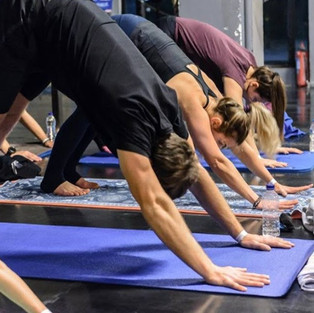A Beginner's Guide to 6 Major Styles of Yoga
- Steph

- Feb 22, 2019
- 4 min read

You want to give yoga a try, but after checking out classes in your area, you’re left feeling a bit puzzled. Should you go to Ashtanga, or Hatha? What is the difference? Are they beginner friendly? How hot is hot? The selection can be overwhelming!
For those out there who are new to yoga, don’t be scared. Yoga is more of an umbrella term, there are multiple styles, with varying levels of difficulty. There are some styles that are more spiritual, some that are more physically demanding. Try out a few different styles, and teachers, until you hopefully find the one that resonates best with you. Even for the seasoned yogis out there, testing out some different styles can enhance your overall yoga experience and push you to break out of your comfort zone.
We are constantly testing out different styles and thoroughly enjoy the different challenge each style brings.
HATHA YOGA
Hatha classes tend to be slower moving classes that teach you the basic postures. You will be guided into a posture and then hold it for a few breaths. It is often considered to be a gentler form of yoga. The Sanskrit term hatha actually signifies any form of yoga that demonstrates physical postures.
Best for: Beginners. Classes are usually slower paced than other styles. Hatha classes provide a classic approach to breathing and exercises. If you are brand new to yoga, hatha is a great entry point.
VINYASA YOGA
Vinyasa is the most athletic yoga style. Teachers arrange their classes to smoothly transition from pose to pose, with the intention of linking breath to movement. In most classes you won’t hold poses for very long and the pace can be pretty quick, so expect your heart rate to rise! Vinyasa styles can vary depending on your teacher, there is no set sequence of poses. You may also see a vinyasa class described as a flow class, which refers to the continuous flow from one posture to the next.
Best for: those who like a physical challenge. Due to its faster pace people who exercise at a high intensity are drawn to Vinyasa.
ASHTANGA YOGA
Ashtanga yoga involves following a very challenging sequence of postures. This style is not suited to beginners. Much like with Vinyasa Yoga, each pose is linked with breath, however Ashtanga always follows the same sequence of postures, in the same order. There are multiple series within Ashtanga, and each series is a prescribed sequence of asanas. If you see a Mysore Ashtanga class, it is expected of you to know the series as there will not be a teacher leading the class. There will always be a teacher in the room to offer help if needed.
Best for: those looking for a challenge, and a way to mark progress. Perfectionists will also enjoy the routine of Ashtanga.
BIKRAM YOGA
Bikram yoga is not for the faint hearted. It consists of a specific series of 26 poses and 2 breathing drills performed in a room which is heated up to approximately 40 degrees Celsius and 40 percent humidity. Every Bikram studio will take you through the same 90-minute practice, so once you are familiar with it you will know exactly what to do. If you are new to Bikram take it easy, rest when you feel light headed and make sure to hydrate before. Despite being a set sequence like Ashtanga, the poses are less challenging than Ashtanga and there is less room to develop each posture.
Best for: People who enjoy an established routine, and who like to sweat. Those who are more recent yogis might gravitate towards Bikram because of its predictable sequence.
YIN YOGA
Yin is a much slower paced style. Poses can be held for several minutes at a time and are mainly seated postures. This meditative practice is designed to apply moderate pressure to your connective tissues, with the desired aim of boosting circulation in the joints and advancing flexibility. Despite being passive, Yin yoga can be quite challenging, especially If you’re body is not accustomed to such long holds. You will use props, such as yoga blocks, which will allow your body to release into the posture. It may also be referred to as restorative yoga.
Best for: People who need a stretch, or purely just to unwind. It can be a great practice for athletes to calm down their nervous system and to relax their muscles and joints. Yin yoga is not suggested for people who are super flexible (as you might overdo it in some poses) or for anyone who has a connective tissue disorder.
HOT YOGA
Like Bikram yoga, Hot yoga is practiced in a heated room. However, the classes vary in Hot yoga, it does not follow a set sequence like that of Bikram. The extra heat can help us to move deeper into poses, just be wary not to overdo it.
Best for: people who love to sweat. If you like a demanding workout that will get your heart pumping, sign up for hot yoga!
This is by no means a full list, but it should hopefully help you pick a place to start when looking at a yoga schedule. Keep us posted on your yoga journey and your favourite styles!






















Simple and clear - perfect. Thank you